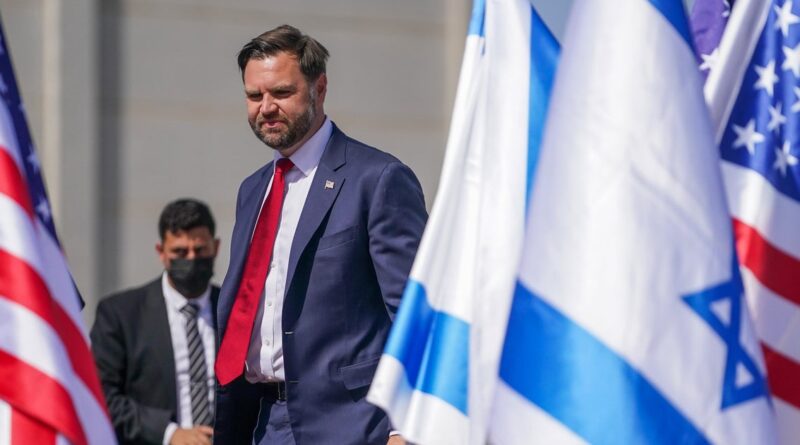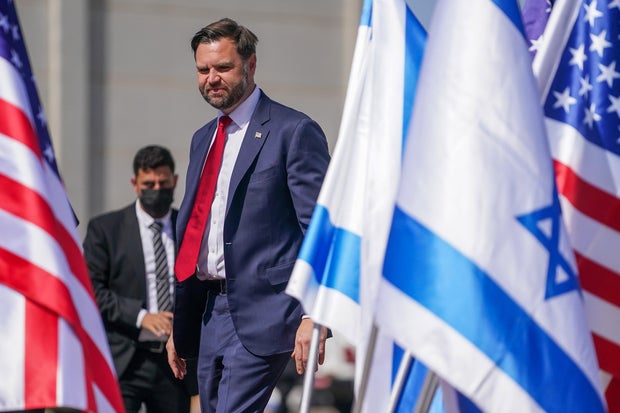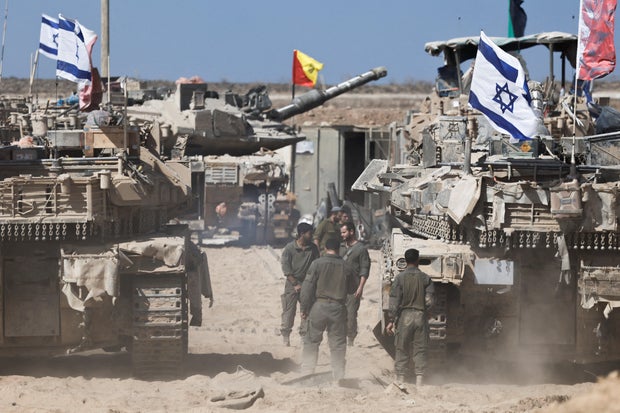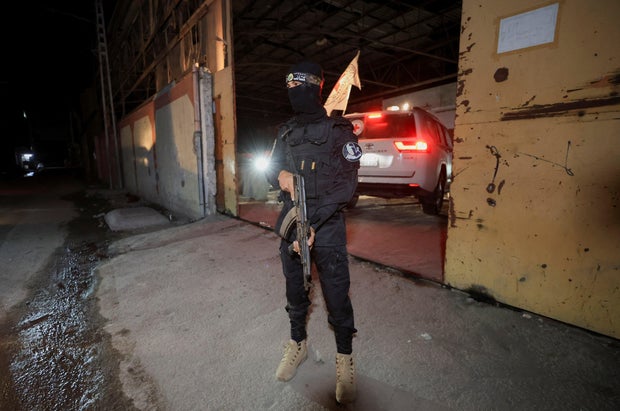As Vance arrives to bolster the Gaza ceasefire, how committed are Hamas and Netanyahu to peace?
Vice President JD Vance, as well as President Trump’s negotiating team — his son-in-law Jared Kushner and U.S. special envoy Steve Witkoff — are all in Israel on Tuesday, trying to shore up the fragile ceasefire in Gaza. Before he left for Israel, Vance said bumps in the road to peace were expected.
“There are gonna be fits and starts,” Vance told reporters. “Hamas is gonna fire on Israel, Israel’s gonna have to respond, of course.”
Hamas has denied responsibility for an alleged RPG attack that killed two Israeli soldiers over the weekend. Israeli Prime Minister Benjamin Netanyahu said Monday that it was a Hamas attack, and that the Israeli military responded to the alleged ceasefire violation by dropping almost 169 tons of bombs in Gaza.
“One of our hands holds a weapon, the other hand is stretched out for peace,” Netanyahu told lawmakers on Monday. “You make peace with the strong, not the weak. Today Israel is stronger than ever before.”
The Israeli strikes killed at least 45 Palestinians, according to health officials in the Hamas-ruled territory.
President Trump warned Hamas on Monday against breaching the deal that took months to negotiate.
“They’re gonna behave, they’re gonna be nice,” he said. “And if they’re not, we’re gonna go and eradicate them if we have to.”
Kushner and Witkoff met Monday with Netanyahu, and the Israeli leader’s office said Vance would also meet him this week. The vice president and second lady Usha Vance were greeted upon their arrival Tuesday by U.S. Ambassador to Israel Mike Huckabee, Israeli Ambassador to the U.S. Yechiel Leiter and Israel’s Minister of Justice Yariv Levin.
Nathan Howard/Pool/Getty
Vance was scheduled to have a working lunch with Witkoff and Kushner on Tuesday before his meeting with Netanyahu.
The peace process has taken incremental steps forward despite the weekend violence, with Israel returning the remains of 15 Palestinians to Gaza on Tuesday following the handover by Hamas on Monday evening of the body of another deceased hostage. As part of the peace deal, a total of 165 Palestinians’ bodies have now been returned to Gaza, many of them former detainees, while all 20 living Israeli hostages have been released by Hamas, along with the remains of 13 deceased captives.
But despite those steps, the long-term viability of Mr. Trump’s peace plan, which he’s said will end nearly eight decades of fighting between Israel and the Palestinians, remains less certain.
Ex-Israeli official casts doubt on prospects for Trump’s peace plan
Some Israelis remain skeptical that the Israeli prime minister is genuinely interested in a lasting peace. Among them is fierce Netanyahu critic Alon Pinkas, who served as an advisor to four Israeli foreign ministers.
He told CBS News that Netanyahu signed the peace deal brokered by Mr. Trump, but never really backed its core purpose, or Mr. Trump’s stated goal of securing an enduring peace in the heart of the Middle East.
“This was an agreement he was bullied into,” Pinkas said. “This is an agreement he signed under duress, and now he is developing a new scheme to manipulate Trump.”
Pinkas credited Mr. Trump for doing “something that his predecessors were disinclined or hesitant to do, and that is exert real pressure” on Israel’s leader.
“It worked, but it only worked for the first phase,” Pinkas said, referring to the living Israeli hostages being released and the ceasefire coming into effect.
He said after the weekend’s violence that the deal had been “ostensibly restored, but when Netanyahu says, ‘I’m restoring the ceasefire,’ it’s only because there’s a visit here of the vice president, JD Vance, and because the U.S. sent its envoy.”
Pinkas said he was certain Israeli forces would resume operations in Gaza within days, noting they remained deployed in about half of the Palestinian territory.
Amir Cohen/REUTERS
“The hostages are no longer in danger because they were freed, and Hamas was not decisively destroyed, as Mr. Netanyahu promised and boasted and bragged for two years, so I see a serious incentive for Mr. Netanyahu to resume” an offensive against Hamas, Pinkas told CBS News. “Maybe not on a huge scale, given the agreement, but I do see … a local skirmish that becomes a wider flare-up, that then deteriorates or escalates into a full Israeli military operation.”
Hamas’ top negotiator said Tuesday that the group remained committed to the ceasefire agreement. But President Trump’s peace plan calls for the demilitarization of Gaza, and many analysts, including Pinkas, have doubts that Hamas will willingly hand over all its weapons.
“That’s probably the biggest flaw in the agreement,” said Pinkas. “The agreement in and of itself is a good agreement, but in order for an agreement like that to work, it requires good faith, good will, and trust. None of these ingredients exist. In fact, both sides have a vested interest in not progressing beyond the ceasefire.”
“Hamas wants to lure Israel inside [Gaza] into a de-facto occupation, and mount an insurgency and show to the Palestinians that they are the real resistance. And Netanyahu wants to go in because he knows that if everything stops now and there is progress into the next phases, that almost inevitably means that he will be deemed as the guy who failed to defeat Hamas.”
Pinkas said that while the past two years of war have left Hamas defeated militarily and degraded, “Hamas is not done. Hamas are there, and you see those pictures every day. You show them on CBS — Hamas gangs walking around in battle fatigues, armed. That’s not going to cut it politically for Mr. Netanyahu.”
Dawoud Abu Alkas/REUTERS
Speaking in a recent interview with CBS News’ Tony Dokoupil, Netanyahu said his government had agreed “to give peace a chance,” but he noted that the conditions of Mr. Trump’s 20-point peace plan “are very clear — it’s not only that we get the hostages out without getting our military out, but that we would subsequently have both demilitarization and disarmament. They’re not the same thing. First Hamas has to give up its arms. And second, you want to make sure that there are no weapons factories inside Gaza. There’s no smuggling of weapons into Gaza.”
“We also agreed: Okay, let’s get the first part done. Now let’s give a chance to do the second part peacefully, which is my hope,” the Israeli leader told CBS News.








